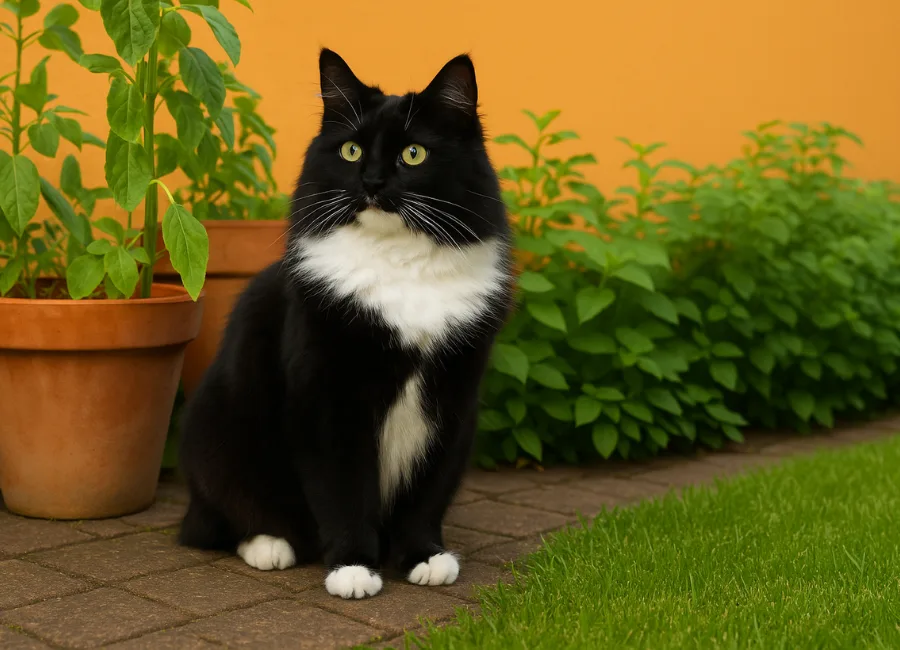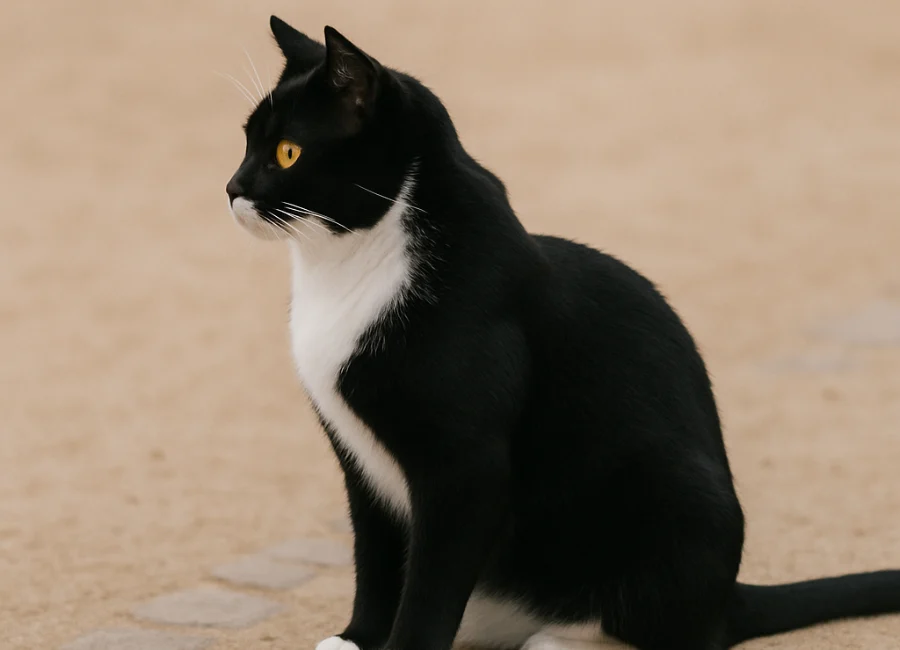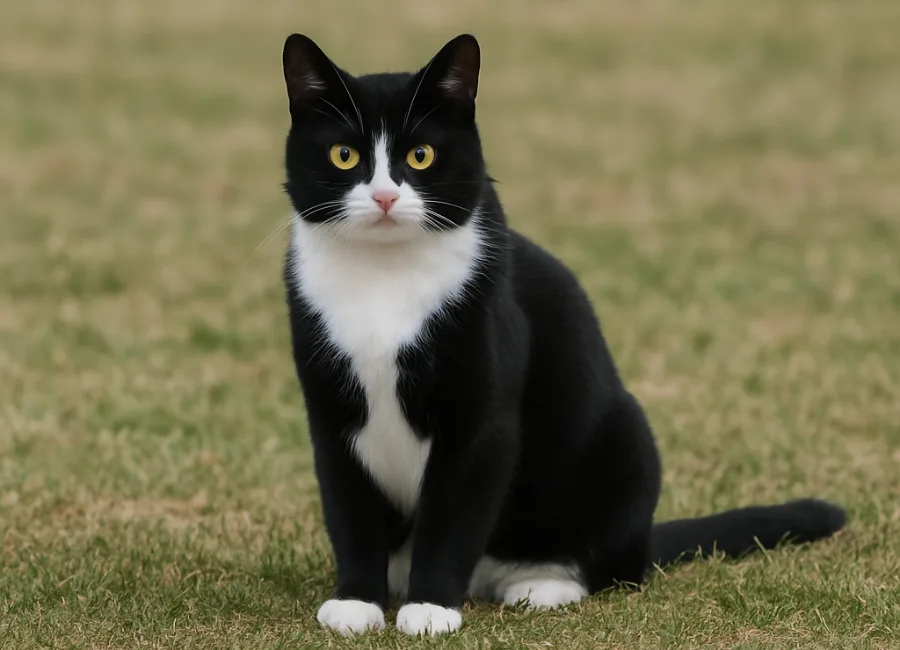If you have ever questioned what a tuxedo cat is, you are about to learn all the intriguing facts about these specially patterned cats. Despite their fancy name, a tuxedo cat isn’t a breed but a specific black-and-white coat pattern that resembles formal wear. Usually on their chests, paws, and occasionally face, these cats have dramatic black fur with white patches that give them that traditional “tuxedo” appearance.
Many people ask: Is a tuxedo cat a breed? The answer is no. Many cat breeds can have tuxedo markings, and they’re just as frequent in mixed-breed cats. You’ll often find this striking pattern in breeds like the Maine Coon, British Shorthair, and Domestic Shorthair. Although it does give them a sophisticated and elegant appearance, the tuxedo design is about their coat color; thus, it does not specify their breed.
Are tuxedo cats intelligent? It is one often asked questions. Many cat experts and owners think tux cats are really inquisitive and intelligent. Their cheerful and intelligent personalities help them to learn quickly; they usually appreciate interactive toys and games. Although every cat’s intelligence may vary, tux cats are noted for being friendly, sociable, and sometimes slightly naughty, which just enhances their appeal.

As for their lifespan, many people are curious about how long tuxedo cats tend to live. Because tuxedo cats originate from numerous breeds, their longevity depends mostly on their genetic history and care. With some living even longer with good nourishment and routine veterinary care, a healthy tuxedo cat may live from 12 to 20 years on average. Are tuxedo cats scarce? The answer is no; tuxedocat rarity is a misconception. You will sometimes find tuxedocats in shelters and homes all across because the black-and-white tuxedo design is rather prevalent in both mixed and purebred cats. Though their beautiful appearance and endearing natures can help to increase their popularity, they are not unique or difficult to locate.
Then what exactly are tuxedo cats? Recognizable by their black-and-white fur, tuxedocats often have white chests and paws that give them the appearance of wearing a formal suit. This color pattern can be shown by cats with short hair or long hair; tuxedocats have become so well-known all over the globe because of their distinctive “formal wear” appearance.
Speaking about the tuxedocat attitude, these cats sometimes turn out to be loving, playful, and loyal companions. Frequently extroverted, they enjoy being with their human family. While some tuxedocats may be more quiet yet still loving, others are quite vocal and To communicate, tuxedocats rely on familiar sounds like meowing and purring. Though their characters vary greatly, one thing is clear: tuxedocats make excellent companions.
You could also be interested in the humorous phrase tuxedocat Lego. This phrase, which occasionally shows up online, relates to inventive LEGO builds inspired by the striking black-and-white pattern of the tuxedocat, Fans of both LEGO and cats express their creativity by designing cute models that mimic the iconic black-and-white tuxedo pattern.
Finally, tux cats have personality and attractiveness in addition to their gorgeous looks. For both households and people, they make wonderful pets since they are intelligent, loving, and mostly healthy cats. Whether you are looking for information about what a tuxedocat is, wondering about their intellect, or simply wondering if they are rare, tuxedocats have a little something special for everyone.
Breed Overview
The word ‘tuxedo’ refers to a coat pattern, not a cat breed, and it’s characterized by a black body with white markings. Usually black fur with white highlights on the chest, feet, and sometimes face defines this look, which evokes a tux suit. Because tuxedo cats range from mixed breeds to those of many breeds, their weight, coat length, and temperament differ greatly. Several popular breeds, including the Maine Coon, British Shorthair, and Domestic Shorthair, can sport the classic tuxedo look.

Tuxedo Cat Characteristics
Tuxedo cats stand out with their elegant black-and-white coats, often showcasing white chests, paws, and facial markings resembling a mask or “bow tie” design, most tuxedos have black bodies. Their eyes can be gold, blue, green, or shades in between. Though the design is always black and white, the form and size of the white areas differ among cats, therefore creating every tux special.
History of the Tuxedo Cat
For centuries, tuxedocats have existed. Their unique pattern results from genetics regulating white spotting combined with black fur. Some individuals think this behavior may be observed in ancient Egyptian cats when they were honored. Famous in books and cartoons, tuxedocats appear in Tuxedocats have been featured in various forms of popular culture, from Dr. Seuss’s The Cat in the Hat to classic animated shows like Felix the Cat and Sylvester from Looney Tunes
Tuxedo Cat Care
General cat care applies, but a tuxedocat’s breed determines its maintenance needs. Steady feeding with balanced cat food, fresh water, and a clean litter box are absolutely necessary. Providing playtime, mental challenges, and a safe indoor setting helps tuxedocats grow and stay happy, just like any other cat. Long-haired tuxedos require more brushing than shorter ones; grooming requirements depend on coat length. Regular veterinary visits ensure top-notch health.
Do Tuxedo Cats Have an Attitude?
Many claim tuxedocats exhibit a distinct character or “attitude.” Usually portrayed as intelligent, confident, and funny. Although personality changes with cat breed and individual, tuxedocats often exhibit social and affectionate characteristics. Some owners find their tuxedos to be especially attractive and occasionally naughty, which only raises their allure.
What Is the Typical Tuxedo Cat Lifespan?
Multiple breeds give rise to tuxedocats; hence, their life depends on genes and upkeep. Usually ranging from 12 to 20 years, Tuxedocats. Correct diet, regular veterinary care, and a safe setting can help tuxedocats, to live long, happy lives.
Common Health Problems
Tuxedocats’ breed determines their inherited health problems. Common health problems in cats include feline immunodeficiency virus, dental disease, obesity, and kidney disease. Keeping your tuxedo cat indoors lowers the risk with regular veterinarian check-ups. No health issues are directly connected to the tuxedo pattern itself.
Appearance
Tuxedocats are distinctive since their black-and-white color looks much like formal attire. Their fur can be of different lengths, but their tuxedo pattern never changes. Often their chests, paws, and sometimes their noses or chins have white markings. Every cat has a unique look as their eyes may be gold, green, or blue.
Diet and Nutrition
Tuxedo cats should consume a balanced diet fit for their breed, age, and health demands. While dry food is also acceptable, wet food usually helps with hydration. Make sure fresh water is always within reach Talk over any particular dietary requirements with your veterinarian, especially if your tuxedocat has weight problems or medical problems.
Where to Adopt or Buy a Tuxedo Cat
Because of their coat pattern, tuxedocats are rather frequent in shelters. Adopting a tuxedocat from a shelter is a smart and compassionate choice. Reputable breeders can offer purebred cats for particular tuxedo-patterned breeds. Always conduct a thorough investigation on breeders to guarantee moral methods.

Types of Tuxedo Cat
Although tuxedocats stand out for their colors, several other breeds might have this pattern. Among the types frequently displaying tuxedo coloring include American Shorthair, Maine Coon, Scottish Fold, and Devon Rex. Though every breed has unique characteristics, the tuxedo style combines them visually.
Tuxedo Cat Overview
Tuxedo cats charm everyone with their elegant black-and-white look and friendly, gentle behavior. Given their pleasant, energetic nature, these cats, which are a coat pattern instead of a breed, can be suitable for several houses. Usually creating strong bonds with their owners, they also enjoy being included in the family.
Pros and Cons
Pros
- Their distinctive black-and-white coat pattern, which resembles a small formal suit, gives tuxedo cats a visual impact and refined elegance.
- Many tuxedocats are famous for being loving, playful, and loyal companions who love connecting with their human families.
- Generally strong, given that tuxedocats come from several breeds, many of them are in good health with proper care.
- Often described as quick and clever learners, tuxedocats provide amusing and intriguing pets.
Cons
- Since tuxedocats are distinguished by their coat pattern rather than breed, their personality, size, and health can vary widely depending on their genetic background.
- Predicting or managing breed-specific health issues gets harder without information about their exact ancestry.
- Should you be looking for a tuxedocat of a specific breed—for instance, a purebred Maine Coon with a tux pattern—they could be rare and more costly to find.
Final Thought
Tuxedocats match elegance with personality exactly. Though not a separate breed, their remarkable black-and-white “formal wear” approach distinguishes them anywhere they go. These cats are excellent companions for families as well as single people because they have intelligence, a playful attitude, and a loving disposition beyond their beautiful appearance. Tux cats have a unique charm that has hypnotized cat aficionados for ages whether you like their unusual looks, are curious about their behavior, or are thinking about welcoming one. These gorgeous felines will lighten your house with years of friendship and pleasure if given the right care and love.
FAQs
Are tuxedocats always male?
No, tuxedocats can be male or female.
How long do tuxedocats live?
Typically between 12 to 20 years, depending on care and breed.
Are tuxedo cats rare?
No, tuxedocats are common due to the prevalence of the black-and-white pattern.
Is a tuxedocat a breed?
Tuxedocats are defined by their coat pattern, not by breed.
Are tuxedocats smart?
Many tuxedocats are intelligent and curious, but this varies by individual.
